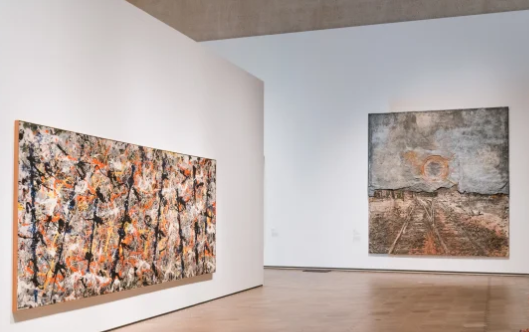Mysteries in Color: The Untold Story of Jackson Pollock’s “Blue Poles

In the vast realm of modern art, few pieces have stirred as much intrigue and debate as Jackson Pollock’s “Blue Poles.” At first glance, the chaotic splatters and tangled threads of color might seem random, but they are the result of a deliberate and intense creative process. Pollock, a pioneer of the abstract expressionist movement, was known for his unique “drip painting” technique, and “Blue Poles” stands as one of its most iconic exemplars.
Also Read:- 10 Pioneering Structures of Post Modernism in Architecture
The painting, originally titled “Number 11,” was created in 1952 during a tumultuous period in Pollock’s life. The swirling blues, fiery reds, and stark poles that dominate the canvas are believed to be a reflection of his inner turmoil and the chaos of the post-war world. But what truly lies behind those enigmatic poles? Are they mere artistic elements, or do they hold deeper symbolic meanings?
Over the years, “Blue Poles” has been the subject of countless interpretations, discussions, and controversies. Its hefty price tag and acquisition by the National Gallery of Australia further fueled its legendary status. This exploration delves into the untold story of “Blue Poles,” unraveling the mysteries behind its creation and its lasting impact on the art world.
Jackson Pollock was an American artist who was once and still is a leading exponent of the art movement in the 1960s. Pollock was introduced to the idea of liquid paint by Muralist David Alfaro Siqueiros at an experimental workshop in New York City. He created some of his most famous paintings during the drip period between 1947 and 1950, including the “Blue Poles”. The painting now hangs illustriously in the National Gallery of Australia since its acquisition from Ben Heller in 1973.
Ben Heller, a New York Art collector who first acquired the artwork from Jackson Pollock, spoke about the Blue Pole – “The oranges, the yellows were terrific, the whites splendid. There was an atmosphere. Gentle and delicate and tough and aggressive. And somehow, they’re all that at the same time. That’s very unusual.”
Today, Ben Heller’s description is our little introduction to the Blue Pole. The description arouses curiosity, and to feed ourselves, let’s look at the artwork to comprehend the artist’s style and context.
What do we perceive? | Blue Poles
Shades of a few colours, randomly poured on without paintbrushes, yes! Using a few sticks to draw those lines before the paint dried, yes! The Color clutter, the mindset the artist would’ve been in while he started the painting, is worth a dig in.
And several vertical pole-like things: They make one fact quite evident. Jackson Pollock rightly named the painting Blue Pole since they seem to be the many things that dominate the artwork.
Pollock started Blue Poles in 1952 when his approach to artwork faced a pivotal shift. He rejected the historical idea of painting on easels where the paint was arranged to resemble something in real life- landscapes or flowers. He made a radical shift from working on easels to unrolling the lengths of the canvas. The Blue Pole was painted on a large roll of prepared canvas that measured 489.5 centimetres wide and 213 centimetres high, using brightly coloured household paints.
Colour and Chaos
Pollock was a man of few colours regarding the Blue Pole. He used the standard colours of commercially produced enamel paints. The artwork boasts the vivid brilliance of ultramarine blue, the deep warmth of cadmium yellow, a reddish-orange like tangerine, thin drips of white, puddles of thickened cream, and squiggles and splashes of black here and there. He also used a shiny silvery paint that was produced from aluminium particles. This metallic paint created a textural contrast when combined with ordinary oil paint, which excited Pollock. The paints were poured on the canvas in layers. Layers of certain colours were left to dry before adding the further ones, while specific colours were layered wet on wet to mix on the canvas. He used sticks, brushes, and syringes to build up rhythmic splashes and finally created the vertical blue poles cutting through the wild drips and gestures. While this technique of random mixing of colours and Pollock’s rhythmic actions created pockets of beautiful marbling patterns on the canvas, a smaller section of the overall paintings had an impression of chaos.
After knowing so much about creation, it is natural for anyone to wonder about two things!
- How could a world-famous artist create artwork by pouring paint on the surface without using any brush medium and without even having to touch the canvas?
- And how did this very randomly created artwork become a masterpiece?
Drip and Splash | Blue Poles
Post the Second World War; artists began to believe that it was no longer possible to create representational art after witnessing something so epically huge. Pollock broke this ice. He wanted to do something no one else was doing at the time. And since then, he has been known for his self-invented “drip painting technique”, in which the painting surface was placed flat on the floor, and liquid household paint was splashed or poured into the surface. This technique gave Pollock the advantage of ‘action and all-over painting’, allowing him to paint the entire canvas from all angles.
Abstract Expressionism
History reveals that Pollock was an artist of Abstract expressionism, one of the leading art movements of the 1960s. As the name implies, abstract expressionism was about expressing, be it states of mind or emotions, through art and abstraction. Most of Pollock’s works were a reflection of his troubled internal state. He was then interested in Jungian psychoanalysis based on a concept of “collective unconsciousness” that all humans share. In the Blue Pole, his erratic painting techniques and tools convey much about the way he felt and thought during the time of painting. Certain stories tell us that Pollock was severely depressed at his studio when his friend Tony Smith visited, and Smith started Blue Pole to distract Pollock from his suicidal thoughts.
The poles painted in an orderly pattern were smashed vertically on the canvas’s surface but at different angles. A footprint at the top right corner of the painting–the artist had the habit of treading over the painting with bare feet during the painting process. The actual painting has shards of broken glass on the canvas.
The mastermind and his masterpiece | Blue Poles
Pollock was a legend during his time, and Blue Pole was produced when his career peaked. Blue Pole was one of his much-appreciated masterpieces.
In August 1949, LIFE magazine asked, “is he the greatest living painter in the United States?” and in 1951, the year before Blue poles were painted, Vogue magazine used his paintings as a hip and happening backdrop to one of its fashion spreads. The director of the Materials Science Institute at The University of Oregon has studied the painting as an example of chaos theory and fractals. He stated that the Blue Pole was an example of a fractal pattern – The basic forms of the drip repeated throughout the painting. Taylor even claimed that Pollock had distilled nature’s essence– fractal and patterning from within his mind and recorded it directly on the canvas.








